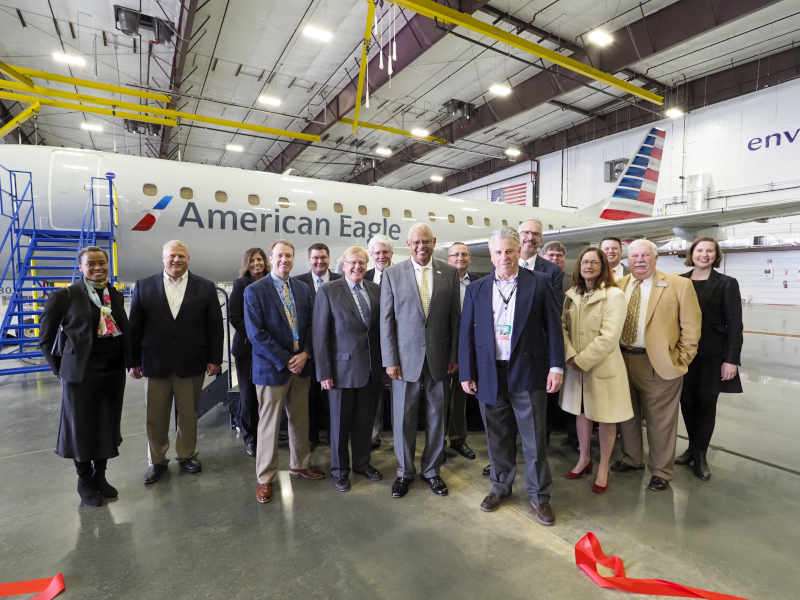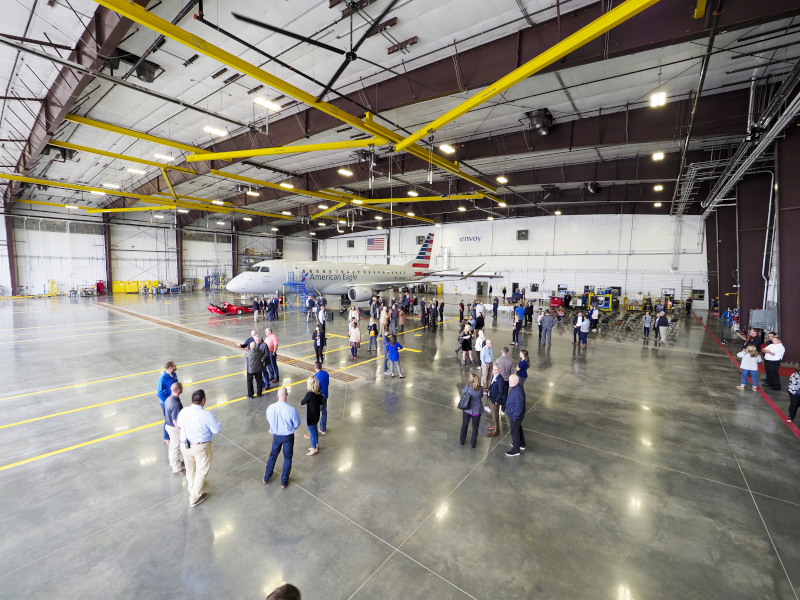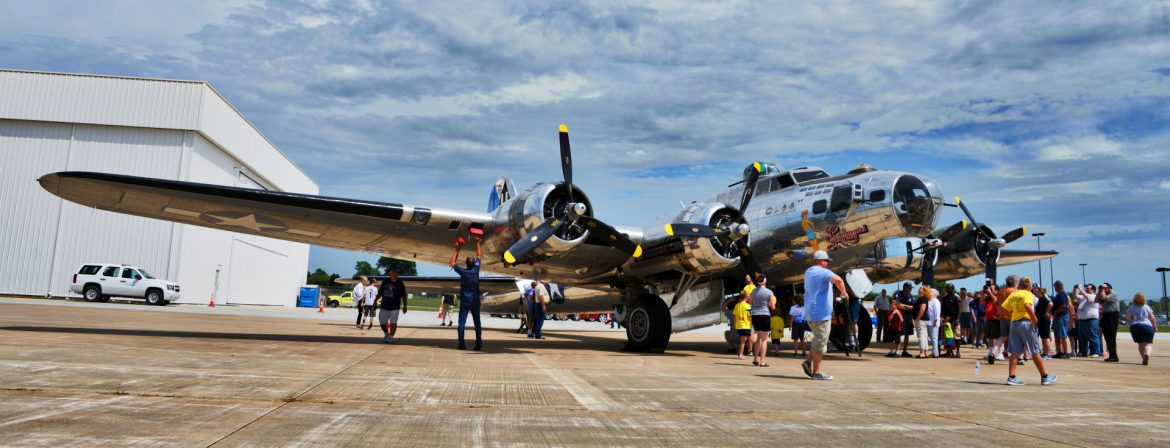Springfield-Branson National Airport
Modern technology and sophisticated service
Planning for sustainable aviation
Springfield-Branson National Airport (SGF) is more than just a gateway- it’s a vibrant part of the community and a welcoming first impression for visitors. Situated in Springfield, Missouri, SGF is a city owned airport offering direct flights to 13 destinations with easy connections worldwide. A source of local pride, the thriving airport is at the center of aviation, economic growth, and community collaboration, and is a critical asset in the region.
A Dynamic Aviation Hub
Classified by the FAA as a small hub commercial service airport, SGF offers a range of services, from commercial airlines to military operations and general aviation. “We have all components of an active and thriving general aviation area,” Brian Weiler, Director of Aviation shares. “The airport actually runs the fixed base operator, but it is rebranded under Midwest Premier Aviation. We have air cargo through UPS and FedEx. We’ve got a fairly large military base that does heavy helicopter maintenance operations.” Beyond this, the airport regularly handles medical helicopters, organ transplant transports, and flights related to the nearby U.S. Federal Medical Center for prisoners.
On the commercial side, SGF partners with American, Delta, United, and Allegiant. These airlines provide access to 13 nonstop destinations, including Dallas, Chicago, and Atlanta. Weiler recounts, “We have about 25 daily flights, and then Allegiant does less than daily service to seven leisure destinations coast to coast, from LA all the way to Florida.”

Addressing Workforce Challenges
One of the most pressing issues in the aviation industry today is the shortage of skilled workers, particularly pilots and mechanics. SGF is helping to address this challenge through partnerships and educational initiatives. “We were successful in 2017, working with Ozark Technical Community College (OTC) to start a fledgling flight school,” says Weiler. Starting out with three aircraft and twenty students, the flight school has steadily grown to include ten aircraft and an enrollment of over 80.
The partnership has grown to include a specialized aviation high school program called Fly SPS, in collaboration with Springfield Public Schools. The program offers hands-on exposure to all aspects of aviation, from air traffic control to aircraft maintenance, laying the groundwork for future careers in the industry. “That’s a really exciting program for us,” Weiler adds.
Recently SGF collaborated with American Airlines and its subsidiary, Envoy, to establish a large maintenance, repair, and overhaul (MRO) facility, specifically designed for Embraer 175 aircraft. “One of the concerns of Envoy during that process was the workforce shortages, and whether they are going to be able to get enough mechanics here locally to staff this facility,” Weiler explains. “That led to continued discussions with OTC about the idea of starting a professional aircraft mechanic technician (AMT) program. And that actually came together very quickly.”
Currently an investment of $13 million is being put towards the construction of the 35,000 square foot AMT training facility. Federal grants, along with support from the state of Missouri, Greene County, and the city of Springfield, all played a role in funding this vital project. The program is set to grow, meeting the increasing demand for mechanics, airline pilots, and corporate pilots. “We’re wrapping up our airport master plan, and we’re actually identifying additional areas, because we think those programs are going to continue to grow to serve the needs of not only the industry here at the airport, but also as a whole,” Weiler conveys. “There is a tremendous need for mechanics and airline pilots and corporate pilots. So that program is coming together very well.”
Master Planning for the Future
As the airport continues to grow, it is guided by a comprehensive plan that outlines ongoing development. “About every 10 years, airports do a forward look for the next 20 years on what things we might need, and so forth,” Weiler relays. “Honestly, we have exceeded all forecasted expectations from the prior master plans, as far as growth in all the areas, and have done most of the projects that were called for.”
The current process includes extensive stakeholder engagement, from corporate pilots and airport businesses to the Springfield Area Chamber of Commerce, the Convention and Visitors Bureau and city leadership. Key initiatives include the development of a new general aviation area to accommodate growing demand, the potential addition of a third cargo operator, and the expansion of airline maintenance facilities. “We’re positioning ourselves not just as a regional hub, but as a key player in the national aviation industry,” Weiler maintains.
The airport benefits from its extensive 3,300-acre property, which allows for current and future development. The master plan defines the potential for a second parallel runway and runway extensions, which Weiler acknowledges are essential for accommodating increasing traffic. “We do own the property for that and also a future extension of a runway that we have,” he confirms.
The new training program at OTC is expected to bolster the local workforce, paving the way for future airline maintenance facilities. “We’ve identified in the master plan at least two, and we have the potential to even put in more airline maintenance, repair and overhaul facilities down the road,” expands Weiler. “That will not only create jobs for the region, but also improve air service down the road. If you give the airlines another reason to be here, if we’re maintaining airline aircraft here in Springfield, we’re more likely going to get more routes and more service.”

Community Integration and Economic Impact
SGF’s impact extends beyond aviation, playing a significant role in the local economy. Kent Boyd, Community Relations Manager and Director of Marketing/Air Service Development, depicts, “We serve approximately a 100 mile circle around the airport. The primary service area is about a 70 mile circle with a population of about a million people, and we’re the primary air transportation port for that area.”
As for the airport’s role as an economic driver, Boyd highlights the importance of increasing passenger numbers on commercial airlines. He says his focus is on raising awareness among the general public and encouraging more people to use the airport. “People had a snapshot in their heads that was probably taken in about 1998, where they still think there are two or three destinations, and the prices are always higher here than they are at bigger hub airports,” he admits.
As part of the effort to change this perception, Boyd employs a mix of traditional and digital marketing strategies, including web advertising, and targeted commercials on streaming platforms like Apple TV and Roku. Boyd says Facebook remains a useful tool for reaching the public, but the focus is primarily on digital outreach to connect with potential travelers and promote the airport’s offerings. “A large part of our marketing effort, really, since we’ve occupied our current terminal, which we opened in 2009, was to try to make the airport a part of the community. Essentially, we’re trying to make the airport a go-to destination,” Boyd portrays.
Springfield-Branson National Airport hosts a yearly awards celebration in collaboration with the Springfield Area Arts Council, transforming the terminal lobby into a banquet hall. In return, the arts council curates and arranges quarterly art displays at SGF. “People have a lot of strong emotions about airports. It’s a place where a lot of different things happen. And in that sense, the airport becomes part of your experience of living in Springfield and the surrounding area,” describes Boyd.
Ongoing Development and Future Prospects
SGF is currently in the final stages of a $6.5 million general aviation terminal expansion and update to the existing 30 year old facility. Weiler depicts, “We’re expanding that from 5,000 to about 8,500 square feet. We are upgrading the exterior of it to provide a front door to our business community and general aviation users.” Other improvements include a plan to replace the five oldest jet bridges at the state of the art 275,000-square-foot terminal, thanks to a $5.5 million grant from the Bipartisan Infrastructure Bill.
Reporting a 10-15% increase in passenger traffic at the airport this year, Boyd underscores the importance of maintaining the current level of service at SGF. “One of the challenges we have as we move forward is making sure we stay on top of all those little details that go towards making a great customer service experience and giving people a reason to fly from here,” he remarks.
In summary, Weiler adds, “We are no longer that really small local airport. We need to be making sure that we have the facilities that we need to keep up with the growth that we are seeing, and also the people, staff, and partners that we have here in the terminal, to make sure that we can continue to provide that outstanding customer service and meet the expectations of our local flying public.”
AT A GLANCE
Springfield-Branson National Airport
What: A growing commercial service airport
Where: Springfield, Missouri
Website: www.flyspringfield.com




